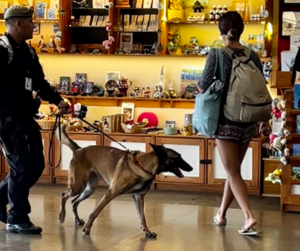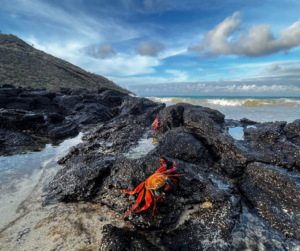Michael Baugh CDBC
You may have seen the headline: “Dogs are Entering a New Phase of Evolution.” The hoopla is over the discovery that some dogs have a genetic variant that makes their oxytocin receptors more sensitive. Linköping University in Sweden did the study. Dogs given a nasal spray of the hormone oxytocin were more likely to seek help from their owners in solving a puzzle. Oxytocin facilitates social bonding, among other things. It’s often misnamed “the love hormone.” The implication: dogs with enhanced oxytocin receptors seek help from their humans, suggesting an evolutionary shift towards dog-human bonding. I can see how folks might make that connection. But it’s a small, preliminary study. Calling this a new phase of evolution might be a stretch. We will see.
One thing we know for sure. Human expectations of dogs have changed. We changed the playing field for dogs a lot.
As recently as the 1990s, most dogs in America lived outside. They caught rats and scared off potential intruders (and neighbor kids and postal carriers). Rural dogs guarded and herded livestock. If a dog slept in your bed, you’d likely wake up with fleas and ticks on you.
 When Dr. Ian Dunbar founded the Association of Pet Dog Trainers in 1993, he called pet dog training a specialty. (APDT later re-named itself The Association of Professional Dog Trainers). Dunbar was ahead of the curve. So was John Katz when he wrote his prescient book, The New Work of Dogs, in 2004. “Dog training was little known and little needed, since most dogs merely wandered their neighborhoods and were seldom walked on leashes.” Katz predicted the shift in how dogs would soon fit into the human condition. It had already begun, in fact. Leave the rats and the sheep outside. Invite the dogs in. They were family. Emotional surrogates. Our friends, counselors and confidants.
When Dr. Ian Dunbar founded the Association of Pet Dog Trainers in 1993, he called pet dog training a specialty. (APDT later re-named itself The Association of Professional Dog Trainers). Dunbar was ahead of the curve. So was John Katz when he wrote his prescient book, The New Work of Dogs, in 2004. “Dog training was little known and little needed, since most dogs merely wandered their neighborhoods and were seldom walked on leashes.” Katz predicted the shift in how dogs would soon fit into the human condition. It had already begun, in fact. Leave the rats and the sheep outside. Invite the dogs in. They were family. Emotional surrogates. Our friends, counselors and confidants.
Katz’s worst predictions also came true. The world changed quickly, and it’s still changing. Human psychology researchers suspect (I think rightly) that we’ve changed technology and social pressures faster than we can keep up. Humans have outpaced our own evolution. We’ve become divisive and isolated. The resulting pressure on our dogs was inevitable. Our powerful hunters and herders now wear clothes. Dogs who retrieved fowl and repelled interlopers are our emotional caregivers. They used to be in the background, outside. Now they are the center of our worlds. It might be too much for them. The evolutionary shift isn’t coming fast enough – for them or us.
An old mentor once said dog breeders could put aggressive dog trainers like me out of business if they started selecting for temperament instead of looks. It’s true. After all, we bred dogs for hunting and herding and guarding. Plus fear, the fuel of aggressive behavior, is heritable in dogs. Why not breed for nicer dogs who can fit into our families better? Fair enough. Breeders have been doing their part. We may not be in a new era of dog evolution. It’s likely we are seeing the results of selective breeding for calmer, more biddable dogs. That is good news, no matter what you call it.
But breeding is not enough.
I started my dog training career in 1999. For well over two decades, my work has been about helping dogs and people understand each other better. It’s been less about militaristic obedience and more about cooperation. Let’s be honest. We are living in a stressful time. The human condition is beautiful but also hard. Teaching a dog how to thrive in our complicated human world can be equally beautiful, and also hard.
We have a long history, we humans and dogs. Fossil records show we have co-evolved for the past 14,000 years. We’ve been in this together. We still are. Oxytocin plays a role and probably has for a long time. If you and your dog spent a few minutes looking lovingly at each other (I recommend it), you would both have increased levels of oxytocin in your bloodstream compared to the baseline levels before you started ogling. And if some dogs are developing better receptors, so be it.
But more oxytocin alone may not be the magic formula. Oxytocin does many things in human bodies. It assists with uterine contractions (the childbirth kind and the monthly kind). It’s also responsible for lactation in new mothers. Oxytocin shows up in men too, enhancing connections with mates and offspring. Like most good things, though, there are side effects. Oxytocin apparently causes in-group bias and increased agitation and aggression toward out-group members. What does that mean? People (and presumably dogs) juiced up on oxytocin may groove on their family and friends, but may also be more likely to shun or attack those who are outside their primary group. Trust me, your dog trainer who specializes in aggression is not excited about that part.
What do we do with all this information? My Latin teacher in high school would say, “jot it down in your gee whiz notebook.” It’s fun stuff, but it won’t show up on any test. Hormones and other neurochemicals are a fascinating, ever-changing soup. We know a little about it. And there is so much more to learn. They definitely play a role in behavior change and a good board certified veterinary behaviorist can help. Genetics plays a role too. Genes are not written in indelible ink. We are learning more about that every day. The environment activates many genes and leaves others quiet. There’s so much more to learn about the genetics of behavior. We’ll uncover that information in time, I’m sure.
Evolution is the slow and steady work of genes. The really good variations get passed on when the organism reproduces. Adaptation results from trial and success. So does learning. It’s the result of trial and success. And, oh my, are our dogs exceptionally developed learners. Learning: dogs have that one nailed.
That’s the true work of dogs. Isn’t it? Learning new skills, new variations on a theme, new ways to live with us. (Oh, we are so unpredicable, we humans). And what about us? What’s the new work of humans? Breathe. Stay present. Be kind to ourselves and others. Those come to mind. Then, ogle at your dog and show him how to be a champ at life with you and the crazy world around him.
Michael Baugh specializes in Aggressive Dog Training in Sedona, Arizona and Houston, Texas.




